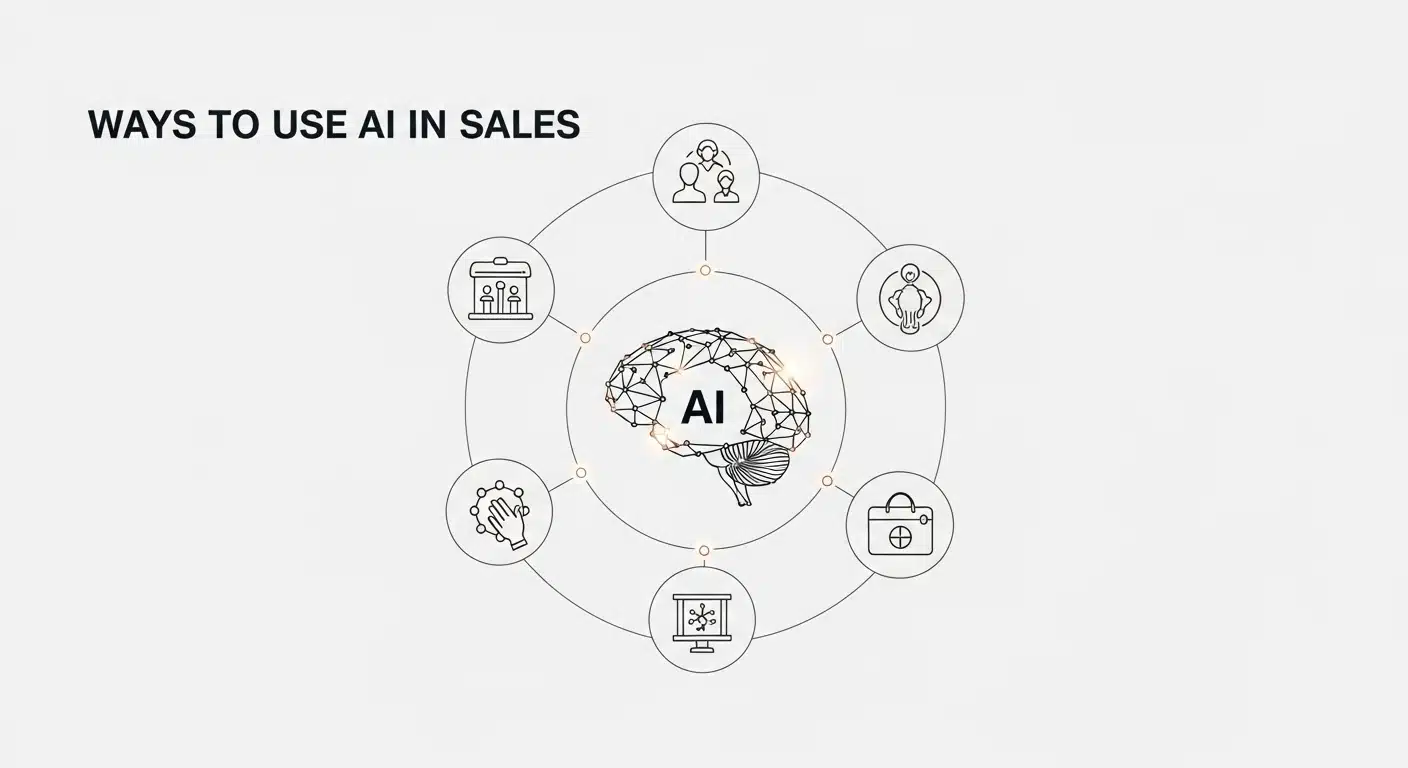You have a long list of people for your sales job. Some might be interested, others not. So you send emails, make calls, take notes, and try to figure out which deals may happen. With the pressure and deadline, you feel drained and see no results.
But what if you had a helper who could do most of this for you? Someone who tells you who’s most likely to buy, writes personalized emails, plans your month, and answers your questions in seconds. Sounds like a dream, right?
Well, that helper isn’t a person; it’s AI, a smart technology built to make work easier and faster.
43% of marketing professionals already utilize AI to automate repetitive tasks, allowing them to devote more time to addressing customer issues and driving conversions.
In this article, we’ll explore eight easy and practical ways to use AI in sales.
8 Smart Ways to Leverage AI for Sales
1. AI-Powered Lead Generation and Scoring
Let us understand how you can use AI in digital marketing. Consider that you are running a digital marketing agency. You get 100 website visitors per day. But can you figure out which one is interested in working with you? Which visitor needs your service?
That is where AI can help.
How does it help?
- AI tools like HubSpot AI or Zoho AI can look at how someone interacts with your site or emails. These tools monitor what the visitors clicked on, how long they stayed on your site, and then score them accordingly.
- It prioritizes leads that are more likely to convert, so your team can focus on nourishing them and building genuine connections.
- Some tools can find new leads for you based on the behavior of your existing customers.
Pro tip: If you’re using LinkedIn for B2B sales, tools like Salesforce Einstein can suggest leads and even tell you the best time to message them.
Lead Generation & Conversion Course
Master Lead Generation & Conversions in our hands-on course. Learn proven techniques to attract, engage, and convert leads into valuable customers.
2. Personalized Customer Engagement
Do you remember the last time you got an email and it felt like it was just written for you? That is how AI writes personalized emails.
Customers want a real connection with brands. They want to feel seen, heard, and understood through messages or calls, and lead generation strategies can help identify the right people to engage with, making it easier to deliver personalized and meaningful interactions.
How does AI help?
- Tools like Drift can analyze what your customers have browsed, liked, or bought.
- It then recommends personalized content like case studies, product suggestions, or pricing plans based on the data it found.
- AI can also find the best time to reach out to each customer to initiate a conversation. It tracks customer behaviors like when they open emails or reply, and accordingly suggests timings.
- AI-powered tools can also create interactive decision trees to guide customers through personalized, step-by-step troubleshooting, ensuring they feel supported and valued during the entire interaction.
Pro tip: Gmail’s Smart Compose uses AI to help you write smarter and faster replies. Why not use it for your follow-ups?
Customer Engagement and Retention Course
Master the art of customer engagement and retention with our hands-on course. Learn proven strategies to build lasting relationships and boost brand loyalty!
3. Sales Forecasting and Demand Planning
Guessing sales numbers won’t help you plan an efficient sales strategy.
AI can predict future sales with accuracy.
How it works:
- AI looks at past data, buying patterns, market trends, and even forecasts what is coming next.
- Tools like Aviso AI can spot trends easily. It finds out when demand may increase or when the product won’t report any sales.
- It helps reduce overstocking or understocking, which saves time and money.
For example, an online fashion store used AI to predict a surge in winter coat demands. With their predictions, they planned a proper marketing strategy and increased their sales.
Pro tip: If you're managing inventory, connect your CRM to AI-powered demand tools. You’ll never be surprised by something unexpected again.
4. Automated Data Entry and Management
Let us be honest: no one loves updating CRMs or customer entries manually and daily. It is tedious and can lead to human errors.
But AI can do it for you.
How it helps:
- Tools like FireFlies.ai can join your calls, take notes, and automatically update your CRM.
- Your chats, calls, and emails are all captured and organized without any manual effort.
- AI can help with preparing invoices or linking your sales tools with finance tools like Xero.
Pro tip: Use tools like Zapier to connect AI tools and automate daily sales tasks.
5. Dynamic Pricing Strategies
Have you ever been in a situation where you bought a flight ticket and then noticed a price change the next day? That is AI-driven dynamic pricing at work.
You can use this in sales, too.
Here’s how:
- AI tools compare your prices with competitors.
- They look at your customer segment. Who are the new buyers vs old buyers, or budget-conscious vs premium, and then adjust the prices accordingly.
- It even predicts when to offer discounts and how much, to close the sale faster without losing profit.
Pro tip: eCommerce tools like Prisync are doing this already. Use them to keep your prices competitive.
6. Enhanced Customer Insights
Want to know about your customers in detail? Like what they prefer or what they care about.
AI can do that for you.
2 ways how AI helps with this:
- Sentiment analysis: Tools like MonkeyLearn can scan reviews, chats, or social media comments. They then showcase how people feel about your brand. They decode the feelings. Are they happy with your brand, frustrated with the experience, or are they just confused? That’s sentimental analysis.
- Behavioral tracking: AI can track what customers do on your website, what they ignore, and where they get stuck. Then it gives clear suggestions on how to improve the content or the strategies.
Pro tip: Use these insights to make personalized pitches, improve your messaging, and rewrite your homepage to answer the questions that your audience has. You can also integrate an AI chatbot to deliver these personalized experiences in real time.
7. AI-Driven Sales Training and Coaching
It feels like having a personal coach for your sales team. The coach watches all your actions and gives you feedback instantly.
How it works:
- Tools like Gong.io or Refract analyze sales calls and give performance tips.
- It tells you things like: Did you talk too much? Did you interrupt? Or did you ask enough questions?
- With time, it helps new sales reps improve their communication skills.
Pro tip: If you are a team leader, use these tools to review calls together. You can also give your insights to ensure your team’s growth. Many leaders join programs like ‘AI Course for Managers and Leaders’ to understand how these tools work and apply them strategically in sales.
8. Visual and Voice Recognition Technologies
AI recognizes faces, objects, and voices. This feature can be used in sales. Surprised right?
Here’s how:
- Imagine in a physical retail store, AI can track which products people pick, how long they search, and even track their facial expressions while buying. This helps you decide the product placement or plan the store layout.
- For example, AI tells you that with product ‘A’, people buy product ‘B’, so you can bring those two products closer together, so it's easy to get product ‘B’.
- You can place orders while doing any activity. Voice assistant tools like Alexa, Siri, or Google Assistant can place orders using voice.
Pro tip: Do you want to create professional product videos? AI-powered video editor tools can generate videos within minutes with realistic avatars and voiceovers.
Real-World Success Stories of AI Boosting Sales Conversions
The best way to understand AI in sales is through real-life examples. Here are three examples of businesses that used AI to close more deals, save time, and improve customer experience.
1. LinkedIn
Have you ever searched for leads on LinkedIn? You know how time-consuming it is. You have to scroll through thousands of profiles to find the best matches. But LinkedIn’s Sales Navigator changes that. It is a perfect use case of AI for business leaders.
Sales Navigator:
- Analyzes your existing customers and finds similar high-quality leads for your business.
- Suggests the best way to connect with people. It can be through mutual contact, a direct message, or by engaging with their posts.
- Finds the buying signals, like whether a company is expanding, raising funding, or hiring for a specific role.
All this reduces endless hours of cold calling. The sales team has warm leads.
2. The Sydney Art Store
This local Australian art supply shop proved that AI is not only for big corporations. They added Rep AI to their system. This is an AI chatbot that works 24/7.
Here’s what it did:
- Increased 25% conversion rates.
- Handled 99% of inquiries on chat.
- Gave 85x increased ROI.
The owner spent less time in customer chats and more time running the business.
3. AA Ireland
AA Ireland is a leading insurance provider. They wanted to reduce the number of missed customer chats and increase the buying process.
They launched a ‘Quote-to-Sale Bot’ and its impact was huge.
- 40% decrease in agent handling time.
- 11+% increase in quote conversion.
- Increased revenue in self-service sales.
The best part was that the bot was built and launched in just 10 weeks.
Future-Proof Your Sales Strategy By Implementing AI
The best learning you can take from this article is: You don’t have to be a tech expert to start using AI in sales.
You just need to take the first step. Choose one of the methods from above and experiment with it. You can first automate the inquiries with a chatbot, send personalized emails, or let AI update customer information automatically.
If you are ready to take the next step, explore Great Learning today. You can access resources, training, and guidance according to your business needs.






